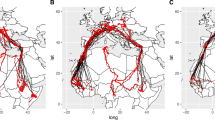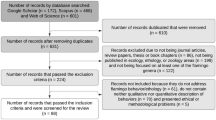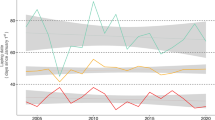Abstract
While seasonal trends in testosterone levels are known from cross-cohort studies, data on testosterone inter-annual individual repeatability in wild birds are rare. Also, our understanding of hormonal age-dependent changes in testosterone levels is limited. We assessed plasma testosterone levels in 105 samples originating from 49 repeatedly captured free-living great tits (Parus major) sampled during the nesting to investigate their relative long-term repeatability and within-individual changes. Furthermore, we examined the inter-annual repeatability of condition-related traits (carotenoid- and melanin-based plumage ornamentation, ptilochronological feather growth rate, body mass, and haematological heterophil/lymphocyte ratio) and their relationships to testosterone levels. We show that testosterone levels are inter-annually repeatable in females, with a non-significant pattern in males, both in absolute values and individual ranks (indicating the maintenance of relative status in a population). In males, we found a quadratic dependence of testosterone levels on age, with a peak in midlife. In contrast, female testosterone levels showed no age-dependent trends. The inter-annual repeatability of condition-related traits ranged from zero to moderate and was mostly unrelated to plasma testosterone concentrations. However, males with elevated testosterone had significantly higher carotenoid-pigmented yellow plumage brightness, a trait presumably involved in mating. Showing inter-annual repeatability in testosterone levels, this research opens the way to further understanding the causes of variation in condition-related traits. Based on a longitudinal dataset, this study demonstrates that male plasma testosterone undergoes age-related changes that may regulate resource allocation. Our results thus suggest that, unlike females, male birds undergo hormonal senescence similar to mammals.



Similar content being viewed by others
Data availability
The data supporting the results are archived in the Dryad repository: https://doi.org/10.5061/dryad.wdbrv15kv.
References
Adámková M, Bílková Z, Tomášek O et al (2019) Feather steroid hormone concentrations in relation to age, sex, and molting time in a long-distance migratory passerine. Ecol Evol 9:9018–9026. https://doi.org/10.1002/ece3.5447
Albrecht T, Vinkler M, Schnitzer J et al (2009) Extra-pair fertilizations contribute to selection on secondary male ornamentation in a socially monogamous passerine. J Evol Biol 22:2020–2030. https://doi.org/10.1111/j.1420-9101.2009.01815.x
Alonso-Alvarez C, Pérez-Rodríguez L, Mateo R et al (2008) The oxidation handicap hypothesis and the carotenoid allocation trade-off. J Evol Biol 21:1789–1797. https://doi.org/10.1111/j.1420-9101.2008.01591.x
Alonso-Alvarez C, Pérez-Rodríguez L, Garcia JT, Viñuela J (2009) Testosterone-mediated trade-offs in the old age: a new approach to the immunocompetence handicap and carotenoid-based sexual signalling. Proc R Soc B Biol Sci 276:2093–2101. https://doi.org/10.1098/rspb.2008.1891
Amet Y, Abalain JH, Daniel JY et al (1986) Testosterone regulation of androgen receptor levels in the uropygial gland of quails (Coturnix coturnix): a further proof for the androgen dependency of the uropygial gland. Gen Comp Endocrinol 62:210–216. https://doi.org/10.1016/0016-6480(86)90111-5
Balthazart J, Turek R, Ottinger MA (1984) Altered brain metabolism of testosterone is correlated with reproductive decline in aging quail. Horm Behav 18:330–345. https://doi.org/10.1016/0018-506X(84)90020-5
Bartoń K (2020) MuMIn: multi-model inference. R package version 1.43.17
Bates D, Mächler M, Bolker BM, Walker SC (2015) Fitting linear mixed-effects models using lme4. J Stat Softw. https://doi.org/10.18637/jss.v067.i01
Bauerová P, Vinklerová J, Hraníček J et al (2017) Associations of urban environmental pollution with health-related physiological traits in a free-living bird species. Sci Total Environ 601–602:1556–1565. https://doi.org/10.1016/j.scitotenv.2017.05.276
Bauerová P, Krajzingrová T, Těšický M et al (2020) Longitudinally monitored lifetime changes in blood heavy metal concentrations and their health effects in urban birds. Sci Total Environ. https://doi.org/10.1016/j.scitotenv.2020.138002
Beletsky LD, Orians GH, Wingfield JC (1992) Year-to-year patterns of circulating levels of testosterone and corticosterone in relation to breeding density, experience, and reproductive success of the polygynous red-winged blackbird. Horm Behav 26:420–432. https://doi.org/10.1016/0018-506X(92)90011-J
Belthoff JR, Dufty AM, Gauthreaux SA (1994) Plumage variation, plasma steroids and social dominance in male house finches. Condor 96:614–625. https://doi.org/10.2307/1369464
Bernstein RM, Setchell JM, Verrier D, Knapp LA (2012) Maternal effects and the endocrine regulation of mandrill growth. Am J Primatol 74:890–900. https://doi.org/10.1002/ajp.22038
Bouwhuis S, Sheldon BC, Verhulst S, Charmantier A (2009) Great tits growing old: selective disappearance and the partitioning of senescence to stages within the breeding cycle. Proc R Soc B Biol Sci 276:2769–2777. https://doi.org/10.1098/rspb.2009.0457
Braude S, Tang-Martinez Z, Taylor GT (1999) Stress, testosterone, and the immunoredistribution hypothesis. Behav Ecol 10:345–350. https://doi.org/10.1093/beheco/10.3.345
Buchanan KL, Evans MR, Goldsmith AR (2003) Testosterone, dominance signalling and immunosuppression in the house sparrow, Passer domesticus. Behav Ecol Sociobiol 55:50–59. https://doi.org/10.1007/s00265-003-0682-4
Burger HG, Dudley EC, Cui J et al (2000) A prospective longitudinal study of serum testosterone, dehydroepiandrosterone sulfate, and sex hormone-binding globulin levels through the menopause transition. J Clin Endocrinol Metab 85:2832–2838. https://doi.org/10.1210/jcem.85.8.6740
Chahal HS, Drake WM (2007) The endocrine system and ageing. J Pathol 211:173–180. https://doi.org/10.1002/path
Crawley MJ (2013) The R book
Davis AK, Maney DL, Maerz JC (2008) The use of leukocyte profiles to measure stress in vertebrates: a review for ecologists. Funct Ecol 22:760–772. https://doi.org/10.1111/j.1365-2435.2008.01467.x
Duckworth RA, Sockman KW (2012) Proximate mechanisms of behavioural inflexibility: implications for the evolution of personality traits. Funct Ecol 26:559–566. https://doi.org/10.1111/j.1365-2435.2012.01966.x
Duckworth RA, Mendonça MT, Hill GE (2004) Condition-dependent sexual traits and social dominance in the house finch. Behav Ecol 15:779–784. https://doi.org/10.1093/beheco/arh079
Evans MR, Goldsmith AR, Norris SRA (2000) The effects of testosterone on antibody production and plumage coloration in male house sparrows (Passer domesticus). Behav Ecol Sociobiol 47:156–163. https://doi.org/10.1007/s002650050006
Fargallo JA, Martínez-Padilla J, Toledano-Díaz A et al (2007) Sex and testosterone effects on growth, immunity and melanin coloration of nestling Eurasian kestrels. J Anim Ecol 76:201–209. https://doi.org/10.1111/j.1365-2656.2006.01193.x
Floch JY, Floch HH, Morfin RF, Daniel JY (1988) Testosterone metabolism and its testosterone-dependent activation in the uropygial gland of quail. Endocr Res 14:93–107. https://doi.org/10.1080/07435808809036342
Folstad I, Karter AJ (1992) Parasites, bright males, and the immunocompetence handicap. Am Nat 139:603–622. https://doi.org/10.1086/285346
Forstmeier W, Schielzeth H (2011) Cryptic multiple hypotheses testing in linear models: overestimated effect sizes and the winner’s curse. Behav Ecol Sociobiol 65:47–55. https://doi.org/10.1007/s00265-010-1038-5
Fusani L (2008) Testosterone control of male courtship in birds. Horm Behav 54:227–233. https://doi.org/10.1016/j.yhbeh.2008.04.004
Galván I, Alonso-Alvarez C (2010) Yolk testosterone shapes the expression of a melanin-based signal in great tits: an antioxidant-mediated mechanism? J Exp Biol 213:3127–3130. https://doi.org/10.1242/jeb.045096
George EM, Rosvall KA (2018) Testosterone production and social environment vary with breeding stage in a competitive female songbird. Horm Behav 103:28–35. https://doi.org/10.1016/j.yhbeh.2018.05.015
Goymann W, Wingfield JC (2014) Male-to-female testosterone ratios, dimorphism, and life history—what does it really tell us? Behav Ecol 25:685–699. https://doi.org/10.1093/beheco/aru019
Greenwood PT, Harvey PH, Perrins CM (1979) The role of dispersal in the great tit (Parus major): the causes, consequences and heritability of natal dispersal. J Anim Ecol 48:123–142
Griffith SC, Parker TH, Olson VA (2006) Melanin-versus carotenoid-based sexual signals: is the difference really so black and red? Anim Behav 71:749–763. https://doi.org/10.1016/j.anbehav.2005.07.016
Grubb CT (2006) Ptilochronology: feather time and the biology of birds. Oxford University Press
Grunst AS, Rotenberry JT, Grunst ML (2014) Age-dependent relationships between multiple sexual pigments and condition in males and females. Behav Ecol 25:276–287. https://doi.org/10.1093/beheco/art124
Guindre-Parker S, Love OP (2014) Revisiting the condition-dependence of melanin-based plumage. J Avian Biol 45:29–33. https://doi.org/10.1111/j.1600-048X.2013.00190.x
Harman SM, Metter EJ, Tobin JD et al (2001) Longitudinal effects of aging on serum total and free testosterone levels in healthy men. J Clin Endocrinol Metab 86:724–731. https://doi.org/10.1210/jcem.86.2.7219
Hau M, Goymann W (2015) Endocrine mechanisms, behavioral phenotypes and plasticity: known relationships and open questions From New Perspectives in Behavioural Development: Adaptive Shaping of Behaviour over a Lifetime? Front Zool 12:1–15. https://doi.org/10.1186/1742-9994-12-S1-S7
Hegyi G, Szigeti B, Torok J, Eens M (2007) Melanin, carotenoid and structural plumage ornaments: information content and role in great tits Parus major. J Avian Biol 38:698–708. https://doi.org/10.1111/j.2007.0908-8857.04075.x
Hernández-López L, Cerda-Molina AL, Díaz-Díaz G et al (2012) Aging-related reproductive decline in the male spider monkey (Ateles geoffroyi). J Med Primatol 41:115–121. https://doi.org/10.1111/j.1600-0684.2011.00528.x
Holtmann B, Lagisz M, Nakagawa S (2017) Metabolic rates, and not hormone levels, are a likely mediator of between-individual differences in behaviour: a meta-analysis. Funct Ecol. https://doi.org/10.1111/1365-2435.12779
Kempenaers B, Peters A, Foerster K (2008) Sources of individual variation in plasma testosterone levels. Philos Trans R Soc B Biol Sci 363:1711–1723. https://doi.org/10.1098/rstb.2007.0001
Ketterson ED (1992) Hormones and life histories : an integrative approach. Am Nat 140:S33–S62. https://doi.org/10.1086/285396
Ketterson ED, Nolan V, Wolf L et al (1991) Testosterone and avian life histories: the effect of experimentally elevated testosterone on corticosterone and body mass in dark-eyed juncos. Horm Behav 25:489–503. https://doi.org/10.1016/0018-506X(91)90016-B
Ketterson ED, Nolan V, Sandell M (2005) Testosterone in females: Mediator of adaptive traits, constraint on sexual dimorphism, or both? Am Nat 166:S85-98. https://doi.org/10.1086/444602
Kimball RT (2006) hormonal control of coloration. In: Bird coloration I: measurements and mechanism. Harvard University Press, Cambridge
Klipker K, Wrzus C, Rauers A et al (2017) Within-person changes in salivary testosterone and physical characteristics of puberty predict boys’ daily affect. Horm Behav 95:22–32. https://doi.org/10.1016/j.yhbeh.2017.07.012
Kraus S, Krüger O, Guenther A (2020) Zebra finches bi-directionally selected for personality differ in repeatability of corticosterone and testosterone. Horm Behav. https://doi.org/10.1016/j.yhbeh.2020.104747
Kuznetsova A, Brockhoff PB, Christensen RHB (2017) {lmerTest} package: tests in linear mixed effects models. J Stat Softw 82:1–26. https://doi.org/10.18637/jss.v082.i13
Madsen V, Valkiunas G, Iezhova TA et al (2007) Testosterone levels and gular pouch coloration in courting magnificent frigatebird (Fregata magnificens): variation with age-class, visited status and blood parasite infection. Horm Behav 51:156–163. https://doi.org/10.1016/j.yhbeh.2006.09.010
Møller AP, Mateos-González F (2018) Plumage brightness and uropygial gland secretions in barn swallows. Curr Zool 65:177–182. https://doi.org/10.1093/cz/zoy042
Montano GA, Robeck TR, Steinman KJ, O’Brien JK (2017) Circulating anti-Müllerian hormone concentrations in relation to age and season in male and female beluga (Delphinapterus leucas). Reprod Fertil Dev 29:1642–1652. https://doi.org/10.1071/RD15537
Montgomerie R (2006) Analyzing colors. In: Bird coloration I: mechanisms and measurements. Harvard University Press, Cambridge
Moreno J, Gil D, Cantarero A, López-Arrabé J (2014) Extent of a white plumage patch covaries with testosterone levels in female Pied Flycatchers Ficedula hypoleuca. J Ornithol 155:639–648. https://doi.org/10.1007/s10336-014-1046-8
Moreno-Rueda G (2017) Preen oil and bird fitness: a critical review of the evidence. Biol Rev 92:2131–2143. https://doi.org/10.1111/brv.12324
Nakagawa S, Schielzeth H (2013) A general and simple method for obtaining R2 from generalized linear mixed-effects models. Methods Ecol Evol 4:133–142. https://doi.org/10.1111/j.2041-210x.2012.00261.x
Needham KB, Dochtermann NA, Greives TJ (2016) General and Comparative Endocrinology Consistent individual variation in day, night, and GnRH-induced testosterone concentrations in house sparrows (Passer domesticus). Gen Comp Endocrinol. https://doi.org/10.1016/j.ygcen.2016.12.010
Nisbet ICT, Finch CE, Thompson N et al (1999) Endocrine patterns during aging in the common tern (Sterna hirundo). Gen Comp Endocrinol 114:279–286. https://doi.org/10.1006/gcen.1999.7255
Ottinger MA (1996) Aging in the avian brain: neuroendocrine considerations. Semin Avian Exot Pet Med 5:172–177. https://doi.org/10.1016/s1055-937x(96)80006-5
Perret M (1992) Environmental and social determinants of sexual function in the male lesser mouse lemur (Microcebus murinus). Folia Primatol 59:1–25. https://doi.org/10.1159/000156637
Peters A, Cockburn A, Cunningham R (2002) Testosterone treatment suppresses paternal care in superb fairy-wrens, Malurus cyaneus, despite their concurrent investment in courtship. Behav Ecol Sociobiol 51:538–547. https://doi.org/10.1007/s00265-002-0472-4
Pinheiro J, Bates D, DebRoy S, Sarkar D (2019) {nlme}: linear and nonlinear mixed effects models
Quesada J, Senar JC (2006) Comparing plumage colour measurements obtained directly from live birds and from collected feathers: the case of the great tit Parus major. J Avian Biol 37:609–616. https://doi.org/10.1111/j.0908-8857.2006.03636.x
R Core Team (2017) R: A language and environment for statistical computing. R Foundation for Statistical Computing, Vienna, Austria. URL. https://www.R-projectorg/
Rosvall KA, Bentz AB, George EM (2020) How research on female vertebrates contributes to an expanded challenge hypothesis. Horm Behav 123:104565. https://doi.org/10.1016/j.yhbeh.2019.104565
Rull IL, Nicolás L, Neri-Vera N et al (2016) Assortative mating by multiple skin color traits in a seabird with cryptic sexual dichromatism. J Ornithol 157:1049–1062. https://doi.org/10.1007/s10336-016-1352-4
Ryder TB, Horton BM, Moore IT (2011) Understanding testosterone variation in a tropical lek-breeding bird. Biol Lett 7:506–509. https://doi.org/10.1098/rsbl.2010.1219
Ryder TB, Dakin R, Vernasco BJ et al (2020) Testosterone modulates status-speci fic patterns of cooperation in a social network. Am Nat. https://doi.org/10.1086/706236
Schindelin J, Rueden CT, Hiner MC, Eliceiri KW (2015) The ImageJ ecosystem: an open platform for biomedical image analysis. Mol Reprod Dev 82:518–529. https://doi.org/10.1002/mrd.22489
Schoech SJ, Mumme RL, Wingfield JC (1996) Delayed breeding in the cooperatively breeding Florida scrub-jay (Aphelocoma coerulescens): inhibition or the absence of stimulation? Behav Ecol Sociobiol 39:77–90. https://doi.org/10.1007/s002650050269
Seddon RJ, Klukowski M (2012) Influence of stressor duration on leukocyte and hormonal responses in male southeastern five-lined skinks (Plestiodon inexpectatus). J Exp Zool Part A Ecol Genet Physiol 317:499–510. https://doi.org/10.1002/jez.1742
Senar JC, Quesada J (2006) Absolute and relative signals: a comparison between melanin-and carotenoid-based patches. Behaviour 143:589–595. https://doi.org/10.1163/156853906776759484
Senar JC, Figuerola J, Pascual J (2002) Brighter yellow blue tits make better parents. Proc R Soc B Biol Sci 269:257–261. https://doi.org/10.1098/rspb.2001.1882
Smith LC, Raouf SA, Bomberger Brown M et al (2005) Testosterone and group size in cliff swallows: testing the “challenge hypothesis” in a colonial bird. Horm Behav 47:76–82. https://doi.org/10.1016/j.yhbeh.2004.08.012
Stoffel MA, Nakagawa S, Schielzeth H (2017) rptR: repeatability estimation and variance decomposition by generalized linear mixed-effects models. Methods Ecol Evol 8:1639–1644. https://doi.org/10.1111/2041-210X.12797
Svensson L, Baker K (1992) Identification guide to European passerines, 4th edn. British Trust for Ornithology, Stockholm
Svobodová J, Gabrielová B, Synek P et al (2013) The health signalling of ornamental traits in the Grey Patridge (Perdix perdix). J Ornithol 154:717–725. https://doi.org/10.1007/s10336-013-0936-5
Svobodová J, Bauerová P, Eliáš J et al (2018) Sperm variation in Great Tit males (Parus major) is linked to a haematological health-related trait, but not ornamentation. J Ornithol 159:815–822. https://doi.org/10.1007/s10336-018-1559-7
Těšický M, Krajzingrová T, Świderská Z et al (2021) Longitudinal evidence for immunosenescence and inflammaging in free-living great tits. Exp Gerontol 154:111527. https://doi.org/10.1016/j.exger.2021.111527
Van De Pol M, Verhulst S (2006) Age-dependent traits: a new statistical model to separate within- and between- individual effects. Am Nat 167:766–773
Van De Pol M, Wright J (2009) A simple method for distinguishing within- versus between-subject effects using mixed models. Anim Behav 77:753–758. https://doi.org/10.1016/j.anbehav.2008.11.006
Van Duyse E, Pinxten R, Eens M (2003) Seasonal fluctuations in plasma testosterone levels and diurnal song activity in free-living male great tits. Gen Comp Endocrinol 134:1–9. https://doi.org/10.1016/S0016-6480(03)00213-2
Vermeulen A, Rubens R, Verdonck L (1972) Testosterone secretion and metabolism in male senescence. J Clin Endocrinol Metab 34:730–735. https://doi.org/10.1210/jcem-34-4-730
Vinkler M, Albrecht T (2010) Carotenoid maintenance handicap and the physiology of carotenoid-based signalisation of health. Naturwissenschaften 97:19–28. https://doi.org/10.1007/s00114-009-0595-9
Vinkler M, Schnitzer J, Munclinger P, Albrecht T (2012) Phytohaemagglutinin skin-swelling test in scarlet rosefinch males: low-quality birds respond more strongly. Anim Behav 83:17–23. https://doi.org/10.1016/j.anbehav.2011.10.001
Wingfield JC, Hegner RE, Dufty AM, Ball GF (1990) The “challenge hypothesis”: theoretical implications for patterns of testosterone secretion, mating systems, and breeding strategies. Am Nat 136:829–846. https://doi.org/10.1086/285134
Whittaker DJ, Rosvall KA, Slowinski SP et al (2018) Songbird chemical signals reflect uropygial gland androgen sensitivity and predict aggression: implications for the role of the periphery in chemosignaling. J Comp Physiol A Neuroethol Sensory, Neural, Behav Physiol 204:5–15. https://doi.org/10.1007/s00359-017-1221-5
Wilcoxen TE, Bridge ES, Boughton RK et al (2013) Physiology of reproductive senescence in Florida scrub-jays: Results from a long-term study and GnRH challenge. Gen Comp Endocrinol 194:168–174. https://doi.org/10.1016/j.ygcen.2013.09.016
Wolf TE, Schaebs FS, Bennett NC et al (2018) Age and socially related changes in fecal androgen metabolite concentrations in free-ranging male giraffes. Gen Comp Endocrinol 255:19–25. https://doi.org/10.1016/j.ygcen.2017.09.028
Zhang H, Vedder O, Becker PH, Bouwhuis S (2015) Age-dependent trait variation: the relative contribution of within-individual change, selective appearance and disappearance in a long-lived seabird. J Anim Ecol 84:797–807. https://doi.org/10.1111/1365-2656.12321
Acknowledgements
We thank Hana Pinkasová, Jitka Vinklerová, Sylvie Dlugošová, Daniel Divín, Julie Vacková, Petra Blahutová, Petra Špatenková, Lenka Pelikánová, Barbora Stolínová, Monika Dvořáková, Martin Rychlý for their assistance with field sampling and Barbora Bílková, Zuzana Świderská and Tomáš Vrkoslav for their help in laboratory. We are also grateful to David Haderkopf for language corrections. We would also like to thank the two anonymous reviewers for their constructive comments on the earlier versions of the manuscript.
Funding
This study was supported by Charles University (Grants Nos. GAUK 1158217, PRIMUS/17/SCI/12 and UNCE 204069), the Czech Science Foundation (Projects 19-20152Y and 15-11782S), Institutional Research Support No. 260571/2021) and by the Grant Agency of the Faculty of Environmental Sciences at the Czech University of Life Sciences Prague (Projects IGA 20144268 and IGA 20154214).
Author information
Authors and Affiliations
Contributions
MT, MV and TA: designed the study. MT, TK, HV, JS, PB, TA and MV: collected samples. MT, TK and JE: performed the laboratory analysis. MT and MV interpreted the data and drafted the manuscript. All authors contributed with their comments to the final approved version of the manuscript.
Corresponding author
Ethics declarations
Conflict of interest
The authors declare no conflict of interest.
Additional information
Communicated by Indrikis Krams.
Supplementary Information
Below is the link to the electronic supplementary material.
Rights and permissions
About this article
Cite this article
Těšický, M., Krajzingrová, T., Eliáš, J. et al. Inter-annual repeatability and age-dependent changes in plasma testosterone levels in a longitudinally monitored free-living passerine bird. Oecologia 198, 53–66 (2022). https://doi.org/10.1007/s00442-021-05077-5
Received:
Accepted:
Published:
Issue Date:
DOI: https://doi.org/10.1007/s00442-021-05077-5




